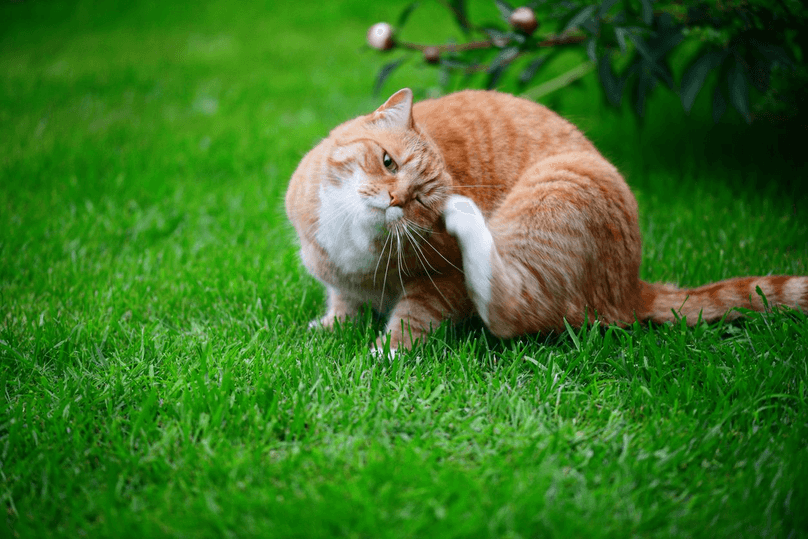
Fleas—they’re a common but unwelcome parasite that can negatively impact your cat’s health. To better control fleas, it’s helpful to understand a little about their life cycle, the symptoms of flea infestation in cats, and the best way to choose a flea treatment or preventative.
If that seems like a lot, don’t worry—we’ll cover everything you need to know to help keep your pet safe and healthy.
The Flea Life Cycle
As parasites, fleas are remarkably efficient and well adapted to their environment. Adult fleas feed on blood from mammals like cats and dogs. When fleas mate and lay eggs, they fall from the host animal’s fur to the ground, where they lay in a dormant pupal state. This pupal state can last from weeks to months, depending on environmental conditions. When the pupae hatch, the young adult fleas survive on detritus until they are mature enough to find a host. An adult female can begin laying eggs within just two days of finding a host. Multiply that by hundreds, and it’s easy to see how quickly flea infestation can get out of control.
Where Did My Cat Get Fleas?
If your cat has fleas, it’s not that your animal is dirty or unhealthy. Fleas are an environmental hazard, and they thrive anywhere there are grasses and animals. From the deep woods to a suburban soccer field, fleas are everywhere. Even cats that spend most of their lives indoors can pick up fleas from the garden or patio—or from contact with an infected animal, including your dog if you have a multi-pet household.
Cats provide an ample host for fleas, offering warmth, dense fur for cover, and of course the flea’s primary nutrient: blood. And because outdoor cats tend to roam, they provide a ready-made transportation system to help fleas spread to new areas (and hosts).
Fleas are also very adaptable to indoor environments and will readily establish themselves in rugs, carpets and bedding.
What Are the Symptoms & Signs of Flea Infestation?
The first symptoms you’ll likely notice are:
- Excessive scratching —fleas like to move about the host. The bites are irritating, making pets more likely to scratch.
- “Cobbing” —nibbling at one area; the base of the tail is a common place.
- Skin irritation at flea bite sites is common and can result in dermatitis, which can become severe in cats that are allergic to fleas.
Another symptom of flea infestation in cats isweakness and lethargy (often signs of anemia), seen most often in severe cases. Very young kittens (<6 weeks) or cats with pre-existing health issues may find it particularly hard to fight off the effects of severe flea infestation. In some cases, the condition could be life-threatening if left untreated.
What Should I Do if My Cat Has Fleas?
Fortunately, most cases of flea infestation are not serious and can be treated at home.
A flea comb will reveal any fleas hidden by the fur. As you gently brush your pet, you may also notice what appear to be tiny dark flecks or scabs—these are actually flea excrement. The amount of “flea dirt” can help you assess the severity of the infestation. Bathing your pet for a few minutes in a gentle dish liquid (Dawn dish soap is excellent!) will kill most of the fleas, washing away both them and their waste. When your pet is calm and dry, try a gentle flea combing to remove any matter that may remain.
If you suspect that your cat has a severe flea infestation, ask your veterinarian to recommend a flea shampoo that’s safe for cats. Be sure to mention the age and overall health of your pet, as some products may not be suited for kittens.
Wash any blankets, rugs or bedding you suspect may be infested. This will help prevent a reinfestation from pupae that may lie dormant in your home.
How Can I Prevent Future Flea Problems?
There are some easy steps you can take to help keep your cat (and your home) flea free!
- Flea-proof your pet. Products like Frontline ® and Advantage™ offer flea collars and topical flea preventatives that protect your pet through flea season and beyond. Some topical preventatives use permethrins–agents that interfere with the flea’s reproductive cycle, killing the adult fleas while preventing females from reproducing. Ask your vet which type of product is best for your cat, and also about oral medications to combat fleas.
- Limit your cat’s outdoor time. The less time your cat spends exploring those grassy areas, the lower the risk for flea exposure.
- Comb your pet regularly. Consistent brushing with a flea comb will help detect fleas before they get out of hand.
- Wash your cat’s bedding. Because fleas can reside in blankets and towels, it’s recommended to wash your pet’s bedding regularly.
If you have concerns or questions about your cat’s health or any flea treatments your pet may require, consult with your veterinarian. They have the expertise and tools to get your pet the treatment it needs, and the peace of mind you deserve.